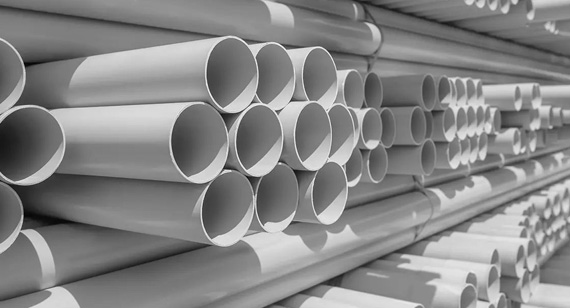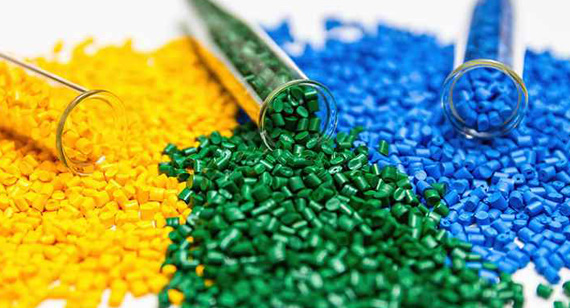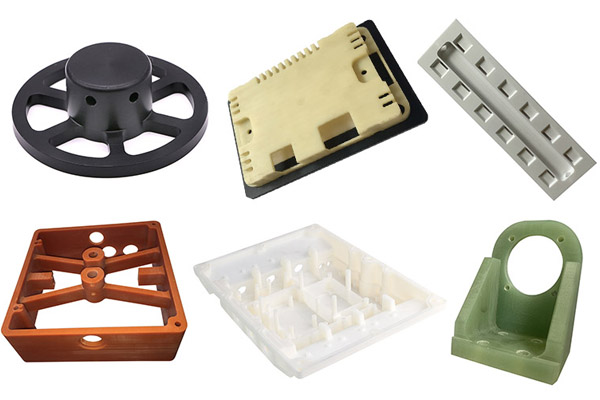15 years one-stop China custom CNC machining parts factory
 2943 |
Published by VMT at Jun 29 2024
2943 |
Published by VMT at Jun 29 2024
Differences Between PVC and ABS
In the field of plastic CNC machining parts manufacturing, PVC (Polyvinyl Chloride) and ABS (Acrylonitrile Butadiene Styrene) are two common plastic materials. Each has unique properties, characteristics, and application areas. This article delves into the differences between PVC and ABS to help readers choose the appropriate plastic material for customized CNC machining projects.
What is PVC?
PVC is a polymer compound made by polymerizing vinyl chloride monomers. Due to its excellent physical and chemical properties, PVC is widely used in construction, electrical power, automotive, and medical industries. PVC has high hardness and strength, along with good wear resistance, corrosion resistance, and temperature resistance.

What is ABS?
ABS is a thermoplastic polymer made by copolymerizing acrylonitrile (A), butadiene (B), and styrene (S) monomers. ABS resin is known for its excellent low-temperature impact resistance, dimensional stability, electrical properties, wear resistance, and chemical resistance. It is widely used in machinery, electrical, textile, automotive, aviation, and chemical industries.

Properties and Characteristics of PVC
PVC has non-flammability, high strength, weather resistance, and excellent geometric stability. PVC is highly resistant to oxidants, reducing agents, and strong acids but can be corroded by concentrated oxidizing acids like concentrated sulfuric acid and concentrated nitric acid. It is unsuitable for contact with aromatic hydrocarbons and chlorinated hydrocarbons. PVC is relatively inexpensive but requires high production technology and specialized molds or screws.
Properties and Characteristics of ABS
ABS offers excellent low-temperature impact resistance, dimensional stability, electrical properties, wear resistance, chemical resistance, dyeability, and ease of processing. ABS resin is resistant to water, inorganic salts, alkalis, and acids but is soluble in aldehydes, ketones, esters, and some chlorinated hydrocarbons. ABS has a low heat deformation temperature, and its heat resistance is relatively poor. While easy to mold, ABS is relatively expensive and has poor aging resistance, potentially discoloring after about a month.
Common Grades of PVC
PVC comes in various grades, such as PVC pipes used for drainage with specifications like dn32, dn40, dn50, dn75, dn110, dn200, dn250, dn400, etc. PVC pipes can also be used as electrical conduits, with specifications such as dn16, dn20, dn25, dn30, etc.
Common Grades of ABS
Market-available flame-retardant ABS grades include ABS-FR, ABS-V0, ABS-UL94, among others. These grades are named based on different flame-retardant levels and usage environments to meet the needs of various industries and fields.
Advantages of PVC and ABS
PVC advantages include low cost, high hardness, good wear resistance, and strong corrosion resistance.
ABS advantages include good low-temperature impact resistance, dimensional stability, and ease of processing.
Disadvantages of PVC and ABS
PVC disadvantages include high production technical requirements and the need for specialized molds or screws. Additionally, PVC can decompose and age under high temperature, high pressure, and UV light, releasing harmful gases.
ABS disadvantages include poor heat resistance, relatively high cost, and poor aging resistance.
In-Depth Comparison of PVC and ABS
Chemical Composition: PVC is primarily made of polymerized vinyl chloride monomers with high hardness and strength. ABS is a copolymer made of acrylonitrile, butadiene, and styrene monomers with good low-temperature impact resistance and dimensional stability.
Application Areas: PVC is widely used in construction, electrical power, and automotive industries. ABS is used more in machinery, electrical, automotive, and chemical industries.
Cost:
PVC: Typically more affordable due to mature production technology and widespread application.
ABS: Relatively more expensive due to the complexity of its copolymer production involving three monomers.
Hardness:
PVC: Moderate hardness, varying with manufacturing methods and formulations.
ABS: Generally higher hardness than PVC, suitable for high-hardness items.
Wear Resistance:
PVC: Good wear resistance, especially in soft PVC.
ABS: Excellent wear resistance, able to withstand significant friction and wear.
Corrosion Resistance:
PVC: Resistant to oxidants, reducing agents, and strong acids, but corroded by concentrated oxidizing acids and unsuitable for contact with aromatic and chlorinated hydrocarbons.
ABS: Resistant to water, inorganic salts, alkalis, and acids, but soluble in aldehydes, ketones, esters, and certain chlorinated hydrocarbons.
Low-Temperature Impact Resistance:
PVC: May become brittle at low temperatures with relatively weak impact resistance.
ABS: Maintains good impact resistance at low temperatures, ideal for cold environments.
Processability:
PVC: Good processability but requires specialized molds or screws.
ABS: Easy to mold and process, widely used in various machining and forming processes.
Chemical Composition:
PVC: Made of polymerized vinyl chloride monomers.
ABS: A terpolymer made of acrylonitrile, butadiene, and styrene.
Physical Properties:
PVC: Excellent geometric stability, weather resistance, and electrical insulation.
ABS: Good dimensional stability, electrical properties, wear resistance, and chemical resistance, but relatively poor heat resistance.
Application Fields:
PVC: Used in construction, electrical power, automotive, medical industries, such as pipes, wire sheaths, toys, etc.
ABS: Widely used in machinery, electrical, textile, automotive, aviation, and chemical industries, such as instrument housings, appliance shells, automotive parts, etc.

Weight and Density:
PVC: Lower density, relatively lightweight.
ABS: Slightly higher density than PVC but still lightweight overall.
Recyclability:
PVC: Recyclable and can be reprocessed into new PVC products.
ABS: Also recyclable and can be reused through appropriate processing methods.
In summary, PVC and ABS have significant differences in cost, hardness, wear resistance, corrosion resistance, low-temperature impact resistance, machinability, chemical composition, physical properties, application fields, weight and density, and recyclability. The choice of material depends on the specific requirements and operating environment of the project.
Application industries of PVC and ABS
PVC materials are used in the construction industry to manufacture doors, windows, pipes, etc.; in the power industry to manufacture wire sheaths, cable sheaths, etc.; in the automotive industry to manufacture body parts, interior decoration parts, etc. ABS materials are used in the machinery industry to manufacture instrument housings, mechanical parts, etc.; in the electrical industry to manufacture electrical appliance housings, junction boxes, etc.; in the automotive industry to manufacture body parts, interior decoration parts, etc.
Choosing the Right Plastic Material for Your Project
Choosing the right plastic material for custom CNC machining projects is crucial. It requires a comprehensive consideration of project-specific needs, usage environment, and cost budget. If a project requires high hardness and wear resistance with cost considerations, PVC might be the better choice. If a project requires excellent low-temperature impact resistance and dimensional stability with a flexible budget, ABS might be the better option.
| Plastic Material | Features | Applications |
| PVC | Cheap price, high hardness, good wear resistance, strong corrosion resistance. | Manufacturing doors and windows, pipes, wire sheaths, cable sheaths, body parts, interior trims, etc. |
| ABS | Good low temperature impact resistance, good dimensional stability, easy processing and molding. | Manufacturing instrument housings, mechanical parts, electrical housings, junction boxes, body parts, interior trims, etc. |
PVC vs. ABS: Which is best for you?
When choosing between PVC and ABS, the key is to understand your project needs and usage environment. If the core of your project is strength, hardness, and cost-effectiveness, PVC may be a more suitable choice. However, if your project requires excellent low-temperature impact resistance, dimensional stability, and processing performance, then ABS may be a better choice.
Conclusion
Through the above in-depth analysis and comparison, we can see that PVC and ABS each have unique properties and characteristics, as well as a wide range of applications. PVC plays an important role in the construction, electricity, automobile and other industries with its excellent physical and chemical properties; while ABS occupies a place in the machinery, electrical, automobile and other manufacturing industries and chemicals with its low-temperature impact resistance and dimensional stability.
In custom CNC machining projects, choosing the right plastic material is crucial. We need to make a comprehensive consideration based on the specific needs of the project, the use environment and the cost budget. If the project has high requirements for hardness and wear resistance, and cost is an important consideration, then PVC may be a more suitable choice. If the project requires the material to have excellent low-temperature impact resistance and dimensional stability, and the cost budget is relatively generous, then ABS may be a better choice.
Finding a Reliable Plastic CNC Machining Partner
When choosing a plastic CNC machining partner, besides material selection, it is essential to consider the equipment, technology, experience, and services of the machining factory. A reliable plastic CNC machining partner should have advanced machining equipment and technology, rich processing experience, and a high-quality service system to ensure projects are completed on time and to high standards.
Therefore, when selecting a plastic CNC machining partner, thorough investigation and comparison should be conducted to choose a factory with professional qualifications, good reputation, and excellent service. By cooperating with a reliable partner, we can ensure smooth project progress and satisfactory machining results.

PVC and ABS Frequently Asked Questions
Which is better, ABS or PVC?
There is no definitive "better" material as their performance and application areas differ. The better choice depends on specific project requirements and usage environments. If the project needs high hardness and wear resistance with cost considerations, PVC may be more suitable. If the project needs excellent low-temperature impact resistance and dimensional stability, ABS may be more suitable.
Which is stronger, PVC or ABS?
Generally, PVC has higher hardness and strength, potentially making it stronger than ABS in certain aspects. However, strength also depends on other factors such as material thickness, structural design, and usage environment.
Why is ABS more expensive than PVC?
ABS is more expensive mainly because its production process is more complex, requiring copolymerization of three different monomers. Additionally, ABS’s excellent low-temperature impact resistance and dimensional stability increase its production cost, making it relatively higher-priced.
Is ABS more brittle than PVC?
ABS is not more brittle than PVC. In fact, ABS has good low-temperature impact resistance, maintaining its toughness and strength in cold environments. PVC, while having higher hardness and strength, may become brittle at low temperatures. Therefore, material selection should consider the specific usage environment.
In summary, PVC and ABS each have their unique properties and characteristics, requiring a comprehensive consideration of project-specific needs and usage environments for selection. By understanding their properties and application areas, we can choose the appropriate plastic material for our projects and find reliable plastic CNC machining partners to ensure project success.
